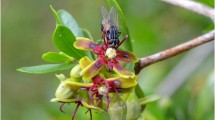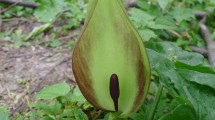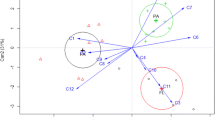Abstract
Scent and coloration of corolla were examined as floral attributes responsible for preferential visiting by the cabbage butterfly, Pieris rapae, to rape flower, Brassica rapa. Floral volatile components that release the flower-visiting behavior of the butterfly were identified by chemical analyses, electroantennography (EAG), and two behavioral bioassays: proboscis extension reflex (PER) in response to odor and attraction to artificial flowers. GC and GC-MS analyses of the headspace volatiles from the flowers revealed the presence of six aromatic compounds, benzaldehyde, phenylacetaldehyde, benzyl alcohol, 2-phenylethanol, phenylacetonitrile, and indole in decreasing order of quantity. Of these, phenylacetaldehyde elicited the highest response in the PER assay. While benzyl alcohol, 2-phenylethanol, benzaldehyde, and phenylacetonitrile evoked moderate responses, the PER-eliciting activity of indole was very weak. In two-choice behavioral bioassays, artificial flowers scented with any one of these PER-active compounds attracted significantly more butterflies than control (unscented) flowers, whereas those treated with indole were almost inactive. The EAG activities of the six chemicals were not high and were about the same at a low dose (1 μg), but phenylacetaldehyde elicited a much stronger response from both sexes at higher doses (10 and 100 μg). An overall profile of EAG responses at a dose of 100 μg was analogous to that of PER performance, suggesting that floral volatiles may be involved in close-range location or recognition of flowers rather than long-range attraction. By spectroscopic and UV-photographic examinations of rape flower, the central part of the corolla was found to absorb UV rays in marked contrast to the other parts, which reflected near-UV rays (λmax = 350 nm). This indicates that the flower is endowed with a conspicuous nectar guide that is probably an important visual stimulus for attracting foraging adults of P. rapae. Consequently, the present findings strongly suggest that this elaborate pollination strategy of rape flower, characterized by its good combination of olfactory and visual attractiveness, accounts for preferential visiting by the cabbage butterfly to the flower.
Similar content being viewed by others
REFERENCES
Blight, M. M., Lemetayer, M., Delegue, M. H. P., Pickett, J. A., Marionpoll, F., and Wadhams, L. J. 1997. Identification of floral volatiles involved in recognition of oilseed rape flowers, Brassica napus by honeybees, Apis mellifera. J. Chem. Ecol. 23:1715-1727.
Cole, R. A. 1976. Isothiocyanates, nitriles and thiocyanates as products of autolysis of glucosinolates in Cruciferae. Phytochemistry 15:759-762.
Dobson, H. E. M. 1994. Floral volatiles in insect biology, pp. 48-70, in E. A. Bernays (ed.). Insect-Plant Interactions, Vol. V. CRC Press, Boca Raton, Florida.
Goulson, D., Ollerton, J., and Sluman, C. 1997. Foraging strategies in the small skipper butterfly, Thymelicus flavus: When to switch? Anim. Behav. 53:1009-1016.
Honda, K. 1973. Olfactory response of adults of butterflies to odorous compounds I. Sasakia charonda Hewitson. Nat. Insect 8:21-24.
Honda, K. 1976. The role of olfactory and color senses in the feeding behavior in the adult of Nymphalis xanthomelas japonica Stichel (Lepidoptera: Nymphalidae), with description of the preference on colors of flowers in the flower-visiting behavior. Trans. Lepid. Soc. Jpn. 27:52-58.
Honda, K., Ômura, H., and Hayashi, N. 1998. Identification of floral volatiles from Ligustrum japonicum that stimulate flower-visiting by cabbage butterfly, Pieris rapae. J. Chem. Ecol. 24:2167-2180.
Horovitz, A., and Cohen, Y. 1972. Ultraviolet reflectance characteristics in flowers of crucifers. Am. J. Bot. 59:706-713.
Kandori, I., and Ohsaki, N. 1996. The learning abilities of the white cabbage butterfly, Pieris rapae, foraging for flowers. Res. Popul. Ecol. 38:111-117.
Kandori, I., and Ohsaki, N. 1998. Effect of experience on foraging behavior towards artificial nectar guide in the cabbage butterfly, Pieris rapae crucivora (Lepidoptera: Pieridae). Appl. Entomol. Zool. 33:35-42.
Kay, Q. O. N. 1976. Preferential pollination of yellow-flowered morphs of Raphanus raphanistrum by Pieris and Eristalis spp. Nature 261:230-232.
KjÆr, A., Ohashi, M., Wilson, J. M., and Djerassi, C. 1963. Mass spectra of isothiocyanates. Acta Chem. Scand. 17:2143-2154.
Knudsen, J. T., Tollsten, L., and BergstrÖm, L. G. 1993. Floral scents—a checklist of volatile compounds isolated by head-space techniques. Phytochemistry 33:253-280.
Lewis, A. C. 1989. Flower visit consistency in Pieris rapae, the cabbage butterfly. J. Anim. Ecol. 58:1-13.
Miyakawa, M. 1976. Flower-visiting behavior of small white butterfly, Pieris rapae crucivora. Annot. Zool. Jpn. 49:261-273.
Tanaka, H. 1982. Relationship between ultraviolet and visual spectral guidemarks of 93 species of flowers and the pollinators. J. Jpn. Bot. 57:146-159.
Tollsten, L., and BergstrÖm, G. 1988. Headspace volatiles of whole plants and macerated plant parts of Brassica and Sinapis. Phytochemistry 27:4013-4018.
Utech, F. H., and Kawano, S. 1975. Spectral polymorphisms in angiosperm flowers determined by differential ultraviolet reflectance. Bot. Mag. Tokyo 88:9-30.
Weiss, M. R. 1995. Associative colour learning in a nymphalid butterfly. Ecol. Entomol. 20:298-301.
Author information
Authors and Affiliations
Rights and permissions
About this article
Cite this article
Ômura, H., Honda, K. & Hayashi, N. Chemical and Chromatic Bases for Preferential Visiting By the Cabbage Butterfly, Pieris rapae, to Rape Flowers. J Chem Ecol 25, 1895–1906 (1999). https://doi.org/10.1023/A:1020990018111
Issue Date:
DOI: https://doi.org/10.1023/A:1020990018111




